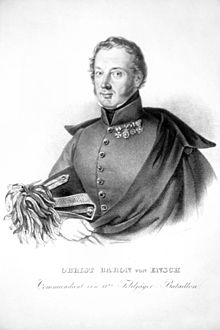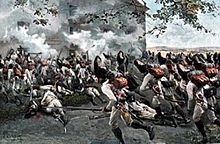Franz von Ensch
Baron Franz Ensch von Badenfeld (born January 16, 1778 in Luxembourg ; † March 15, 1861 in Baden near Vienna ) was an Austrian major general , knight of the Military Maria Theresa Order and member of the Elisabeth Theresa Military Foundation .
Life
In 1792, when he was 14 years old, Ensch started his career as a cadet in Wilhelm Freiherr von Schröder (afterwards “Grand Duke Michael of Russia”) Infantry Regiment No. 26 and attended the siege of Fort St. Louis the following year. The campaigns 1793/96 mitkämpfend on the Rhine and in Italy, he became in this regiment to Lieutenant in June 1800 to lieutenant and received, at the request of Field Marshal Lieutenant Marquis Chasteller, in November 1801, the division into the erected from that in Tyrol Rifle Corps in which the young officer took part in the campaigns in 1799 and 1800. At the request of the Field Marshal Lieutenant Marquis de Chasteler , he was translated qua talis to the Tyrolean Jägerregiment, in which he took part in the campaigns in 1799 and 1800.
On the day of the attack on the position in front of Ulm in October 1805, when the enemy attacked the outpost chain near Ulm on the Michelsberg with force, the first lieutenant was detached at his own request with a hunter company against Haslach to cover the flank where he was Although the enemy attacked with a far superior number of weapons and people, he defended stubbornly for over 14 hours with steadfast courage, despite a thigh shot. Only a second shot in the right hip ended his mission there. He was even thought dead and brought from the battlefield to Ulm . For his act of arms, Ensch was decorated with the Knight's Cross of the Maria Theresa Order in 1808.
For his act of arms Ensch was promoted to lieutenant captain apart from the rank tour, then in the chapter of the Maria Theresa Order ordered for the campaign in 1805 he was unanimously awarded the Knight's Cross (72nd doctorate from March 1, 1808).
In the campaign of 1809 under Archduke Karl , Ensch, now a captain in the 2nd Jäger Battalion, also distinguished himself , took part in the battles of Aspern and Wagram and was highly praised for his brave behavior on July 10th at Schöngrabern in relation to the Archduke.
In 1810, as a born Luxembourger, Ensch was reclaimed by the government of the then French Emperor Napoleon . Since he did not obey this request, he was declared an outlaw by this government. The oath he took to his monarch was binding on him, and he sacrificed his home and wealth.

According to the statutes of the Military Maria Theresa Order, the officer was raised to the hereditary Austrian baron status of the Austrian imperial state on May 22, 1813. Furthermore, in the same year he made significant contributions to the organization of the 11th Jäger Battalion, and on August 5th Emperor Franz I ordered the creation of the same. Ensch was appointed interim commander and on the 13th of the month the officer, on the recommendation of the Court War Council, was promoted to major apart from the rank tour to the definitive battalion commander by the highest resolution . With his battalion he achieved successes in the campaigns of 1814 and 1815 , including the battle on the Ronco on April 21, 1815 against Marshal Murat . He also contributed significantly to the success of the attack on Pesaro on April 28 of that year, as he had a supportive effect. In recognition of his “brave and fruitful service”, he received the Royal Sicilian Order of St. Ferdinand and Merit in 1816 .
On January 27, 1821 he was promoted to lieutenant colonel and battalion commander of the Lombard-Venetian hunter battalion No. 11 in Ragusa . In the campaign against Naples in 1821, Ensch distinguished himself as a commander several times. So after the meeting at Rieti , in which he had acquired the full recognition of his army commander, Count Frimont's cavalry general , he received the order to advance to Abruzzo with a 5,000-strong patrol corps. He fulfilled the difficult task assigned to him with the greatest success by completely restoring the calm in the area assigned to him, about which he was particularly praised by the highest resolution of Emperor Franz I , of April 24, 1821 and assured of the highest grace. His services were also recognized by the King of Naples in the same year by being awarded the Order of St. George of Reunification .
Promoted to colonel in the battalion on January 20, 1831 , Ensch was standing with him on the coast at the time of Emperor Franz I's tour of these areas and was expressed by him with the greatest satisfaction with the good looks, good posture and tactical training delighted the team.
His severe wounds received from the enemy - four gunshot wounds and one stab wound - prompted him to ask for retirement. In consideration of his almost 44 years of extremely loyal service, he was retired on February 29, 1836 with the title of major general and an annual staff bonus of 300 guilders. In 1846, in further recognition of his special and loyal service to the imperial family, Emperor Franz Joseph I appointed him a member of the Elisabeth Theresa Military Foundation.
coat of arms
1813: upright oblong shield converging at the bottom, divided by a right-angled silver bar in red and blue. The bar is marked with a blue star. In the upper left corner of the shield, on the beam, there appears a golden lion directed to an argument with a thrown paw and double tails stretched over the back; in the lower right corner a pelican can be seen on its nest with three cubs. The lion grows out of the crowned helmet. The ceilings are blue-silver and red-gold.
literature
- Franz Graf Alberti de Poja: History of the k. and k. Feldjägerbataillons Nr. 11, printed by R. Brzezowsky & Sons, Vienna 1905.
- Jaromir Hirtenfeld : The military Maria Theresa order and its members. Volume 2, Verlag der Buchhandlung für Militärliteratur Karl Prohaska, Vienna 1857, pp. 816f.
Individual evidence
- ↑ a b Constantin von Wurzbach : Ensch, Franz Freiherr von . In: Biographisches Lexikon des Kaiserthums Oesterreich . 4th part. Typogr.-literar.-artist publishing house. Establishment (L. C. Zamarski, C. Dittmarsch & Comp.), Vienna 1858, p. 54 Error in expression: unrecognized word "r" ( digitized version ).
- ^ Andreas Graf Thürheim: Commemorative sheets from the war history of the Austro-Hungarian army. Volume 2, Verlag K. Prochaska, Vienna 1880, p. 611.
- ↑ Miltary Maria Theresa Order - E to H
- ↑ a b c Valentin von Streffleur (Ed.): Austrian military magazine. Volume II, volume 2, Druck- und Kommissionsverlag Carl Gerold's Sohn, Vienna 1861, p. 244ff.
- ^ Andreas Graf Thürheim: Commemorative sheets from the war history of the Austro-Hungarian army. Volume 1, Verlag Buchhandlung für Militär-Literatur, Vienna 1880, pp. 498, 528f.
- ↑ Austrian observer. No. 100 of April 10, 1821, p. 472.
- ^ General Military Almanac. 1st year, printing and publishing company Karl Wilhelm Leske, Darmstadt 1828, p. 38.
- ^ Franz Sales Kandler: Mirror of Honor of the Imperial and Royal Austrian Army. Verlag Carl Gerold, Vienna 1831, p. 103.
- ^ Antonio Schmidt-Brentano: The kk or kuk generality 1816-1918. Austrian State Archives, 1907, p. 42.
- ↑ Maximilian Gritzner , Ad. Hildebrandt: Luxembourgish nobility. In: Siebmacher's great book of arms. Volume 3, Bauer & Raspe, Nuremberg 1871, p. 4, T. 3.
| personal data | |
|---|---|
| SURNAME | Ensch, Franz von |
| ALTERNATIVE NAMES | Ensch von Badenfeld, Franz (full name) |
| BRIEF DESCRIPTION | Austrian major general |
| DATE OF BIRTH | January 16, 1778 |
| PLACE OF BIRTH | Luxembourg |
| DATE OF DEATH | March 15, 1861 |
| Place of death | Baden near Vienna |



